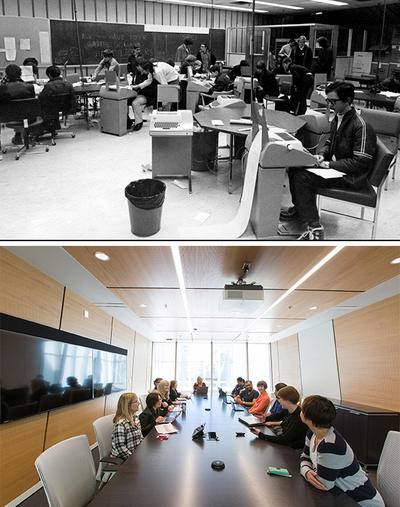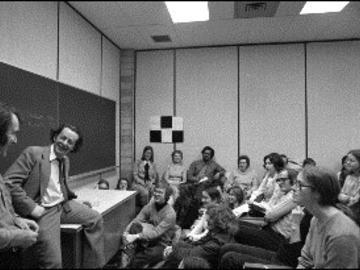April 21, 2016
Celebrating 50 years: Classrooms, then and now

Technology used in classrooms and the overall look and feel of learning spaces has changed.
University Archives and by Riley Brandt, University of Calgary
- Above: In the top photo, visitors use large computers in the Math Department during an open house at the University of Calgary in 1973. Lower photo, students engage in collaborative conversation in a conference room at the new Taylor Institute for Teaching and Learning, where personal laptops and tablets are the norm.
2016 marks 50 years of the University of Calgary being part of this vibrant, energetic city and we have a great deal to celebrate. Led by the Eyes High vision, we’ve become the top-ranked young university in Canada and North America. One of the significant changes over time has been the addition of technology in the classroom, but has the classroom experience changed? As we celebrate the opening of new Taylor Institute for Teaching and Learning this week, we revisit the archives for photos of how the experience in the classroom has changed in five decades.
When you think of a classroom, what comes to mind? Rows of desks with the little writing surfaces that offer just enough space to scribble a bit in a notebook? The teacher at the front — a green or black chalkboard behind them? Possibly a pencil sharpener mounted on the wall? Each room looking pretty much the same as the next?
Sharon Friesen, vice-dean in the Werklund School of Education, remembers that sort of classroom well. She was an undergraduate student in education from 1982 to 1986 at the University of Calgary, and stayed on for both her master's and doctoral degrees. No doubt, she spent time in many of the classrooms seen in the photographs in the university archives that show an earlier period in teaching and learning.
But have they really changed that much? According to Friesen, when it comes to the look and feel of the traditional classroom, the answer is no.
“In our education block, for example, some rooms are still the same. Most of the science theatres haven’t changed much either, and while the building is new and quite amazing, the science labs in EEEL don’t seem to be much different from the labs of the 1980s.”
From typewriters and tape machines to SMARTboards and computer labs
One thing that has changed, says Friesen, as she glances at photos from a time gone by, is the technology.
Gone are the clunky, manual and later, electric typewriters, the television-monitor-videotape-recorder combination units, the reel-to-reel tape machines and the overhead projectors. Wait, not the overheads — they can still be found here and are still the favourite go-to equipment for quite a few professors. But now they are joined by SMARTboards, whiteboards, the occasional computer lab, laptops and tablets.
New Taylor Institute epitomizes connected and collaborative learning space
The other main change in post-secondary education, beyond the physical, is what has been realized in the areas of teaching and learning.
“We know that students need to know that their work makes a difference,” says Friesen. “The work has to be connected and collaborative. There needs to be a forum in which to express ideas and get feedback.
“Students need to be part of a deep and rich dialogue.”
Friesen says this week’s opening of the Taylor Institute for Teaching and Learning is a clear signal that the University of Calgary is taking a step towards presenting what classrooms and learning can, and should, look like.
“It’s clear that what is needed is a cultural shift in our faculty members across this campus, and that’s the vision of the Taylor Institute, that it will be able to help faculty move through this transition in teaching and learning,” says Friesen. “At the opening, it was clear that this is Don Taylor’s vision too.”
'Creating learning environments that optimize learning'
“We put student success as a key element in our Eyes High strategy, and what I heard [at the Taylor Institute opening] is that we want our faculty members to be really strong in effective pedagogy, creating learning environments that optimize learning.
“The Taylor Institute signals a change in direction for post-secondary teaching and learning. Our obligation is to ensure we have highly educated citizens and workforce, and accepting that obligation is our responsibility," she says.
“Hopefully now we can get a critical mass to say that we are attending to all aspects of student learning.”

























